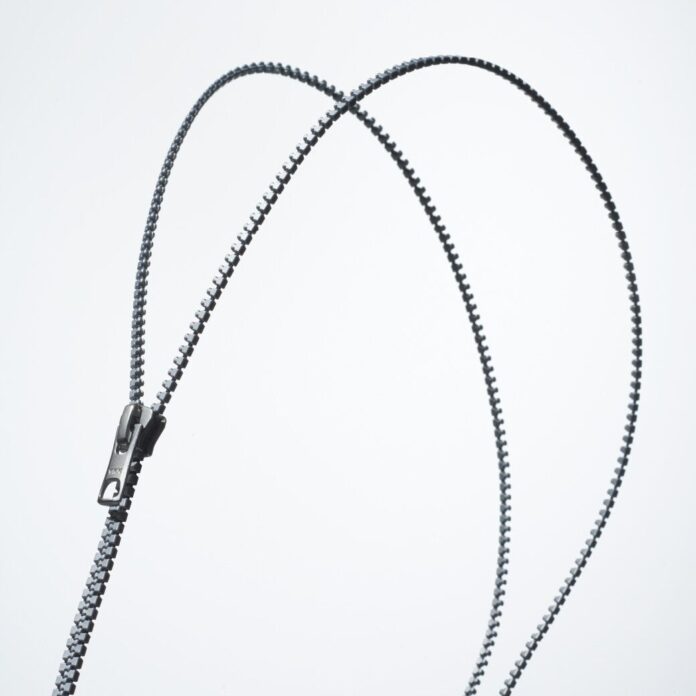For more than a century, the zipper has stayed more or less the same: two interlocking rows of teeth, a sliding pull, and the fabric tape that holds it together. It’s one of those inventions that conquered the world by blending into it. Billions are used every day, yet few people ever stop to think about how they work.
Now, after a hundred years of stasis, YKK, the Japanese company that makes roughly half the world’s zippers, has decided it’s time to rethink the mechanism that holds much of modern clothing together. Their new AiryString zipper looks ordinary at first glance. Then you realize what’s missing: there’s no tape.
That absence transforms everything. Without the woven fabric that normally flanks the teeth, the AiryString is lighter, sleeker, and far more flexible. It’s a small but important redesign that feels almost futuristic in its simplicity, a fastening system that sinks into a garment instead of sitting on top of it.
“We wanted to address the challenges involved in zipper sewing,” says Makoto Nishizaki, vice president of YKK’s Application Development Division. The idea grew out of a collaboration with JUKI Corporation, a leader in industrial sewing machines. Together, the two companies reconsidered how a zipper could be made and how it could merge more seamlessly with fabric. The partnership began in 2017 and made its public debut at the JIAM 2022 Osaka trade show—a detail that hints at how long YKK plays the long game.
If YKK’s name doesn’t ring a bell, check the pull tab on your jackets or pants, because you probably already wear their work. In 2023, the company had more than $6 billion in revenue. Founded in Japan in 1934, the company makes zippers for everyone from Prada and Arc’teryx to Patagonia and The North Face.
Its dominance comes from an unusual level of control: YKK manufactures its own machines, designs its own molds, and even spins its own thread. That self-sufficiency lets it experiment in ways competitors can’t, turning a mundane component into a field for continuous innovation.
Reinventing an Everyday Mechanism
The zipper, as we know it, hasn’t had a real overhaul since the 1910s. Its long reign owes much to reliability—it’s sturdy, inexpensive, and easy to sew. For most of the 20th century, that was enough. But materials have evolved. Designers now work with featherlight nylons, stretch fabrics, and technical blends that behave more like skin than cloth. The old zipper, with its woven borders and stiff seams, has started to feel out of sync with what surrounds it.
“There has been a growing demand from the market for lighter and more flexible garments,” Nishizaki says. “And similar expectations have extended to zippers.” However, removing the tape introduced a host of engineering problems. Those strips of fabric give a zipper its structure and provide the surface tailors sew through. Without them, YKK had to rethink every step of production.
The teeth were redesigned, the manufacturing process rewritten, and new machinery developed to attach the closure to garments. “The absence of the tape posed various production challenges,” Nishizaki says. “We had to develop new manufacturing equipment and a dedicated sewing machine for integration.” The result: a lighter, more flexible system that reduces material use and environmental impact compared with a standard Vislon zipper.
Early adopters are already experimenting. Descente Japan, known for technical sportswear, was among the first to prototype AiryString in 2022. The North Face has selected the system for use in its new Summit Series Advanced Mountain Kit. Smaller brands like Earthletica, an eco-conscious swim and performance label, have also tested it, describing the zipper as “soft, flexible, and almost silent.”
The effect is apparently tactile. Garments move more naturally, lie flatter against the body, and feel less mechanical. “We repeatedly conduct durability and strength tests by sewing AiryString and conventional zippers into various fabrics,” Nishizaki says. “In terms of usability, AiryString offers much smoother operability.” That translates to a softer, slicker glide—the satisfying pull that separates a well-made jacket from a cheap one.
Little Parts, Big Change
On the factory floor, the benefits add up, too. Traditional zippers consume extra fabric and dye and require multiple sewing passes. By removing the tape, YKK says it trims both material and labor. “It contributes to reducing work in customers’ sewing processes,” Nishizaki says. “It also reduces fiber use and water consumption in the dyeing process, lowering CO₂ emissions.”
The math adds up fast. YKK offers a 100 percent recycled-material version of AiryString and claims measurable cuts to greenhouse gas emissions and water usage. The impact is magnified by scale: The company operates in 71 countries and regions, and its trademark is registered in 177. When you make billions of zippers a year, these small efficiencies ripple globally.
That incremental progress mirrors YKK’s founding philosophy, the “Cycle of Goodness.” The principle—that no one prospers without benefiting others—has supposedly guided the company for decades. It’s visible in its other micro-improvements: corrosion-resistant alloys, sound-dampened sliders, recyclable polyester tapes. AiryString continues that tradition, shrinking the zipper’s physical and environmental footprint at once.
Adoption, though, will take time. AiryString can fit into existing workflows, but to unlock its full potential, factories will apparently need specialized sewing equipment. That limits early use to design-led and performance-oriented brands, such as The North Face, willing to retool. Once those experiments prove successful, the technology could spread quickly, especially in an industry where efficiency drives everything from pricing to sustainability.
When asked what zippers might look like in 50 years, Nishizaki doesn’t talk about smart fabrics or AI-assisted closures. He returns to YKK’s mantra: “Little parts. Big difference.” AiryString embodies that principle. It’s not a flashy reinvention, it’s a recalibration. A century-old mechanism made lighter, cleaner, and almost invisible. In a world addicted to louder, faster innovation, YKK’s breakthrough succeeds by subtracting rather than adding.
Disclaimer : This story is auto aggregated by a computer programme and has not been created or edited by DOWNTHENEWS. Publisher: wired.com












